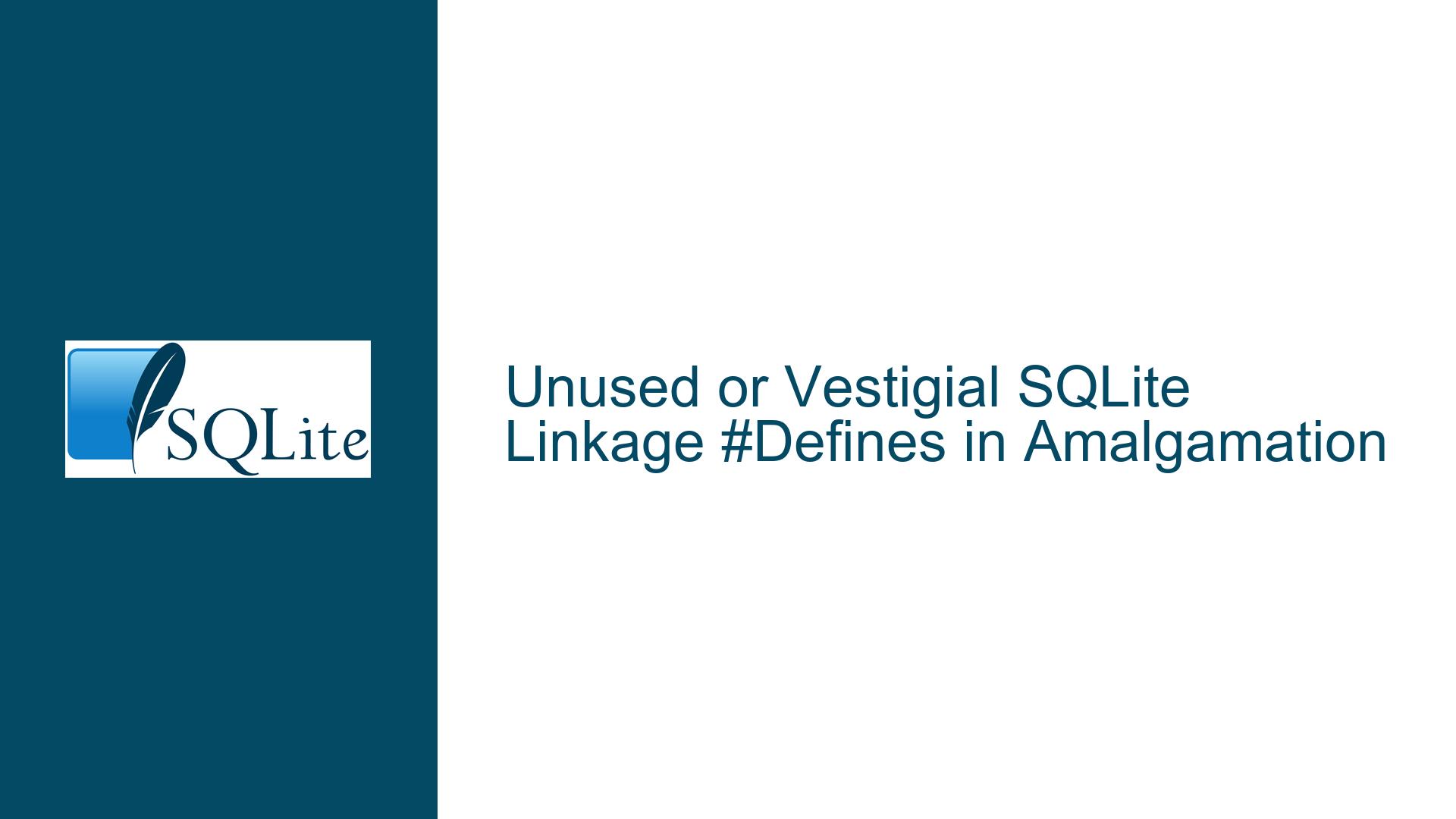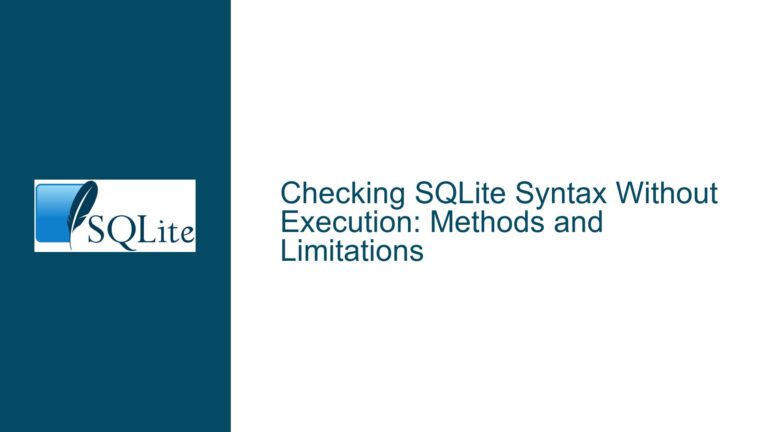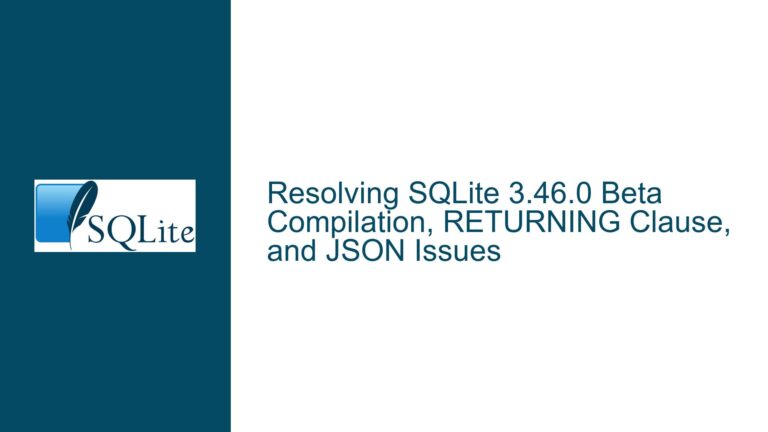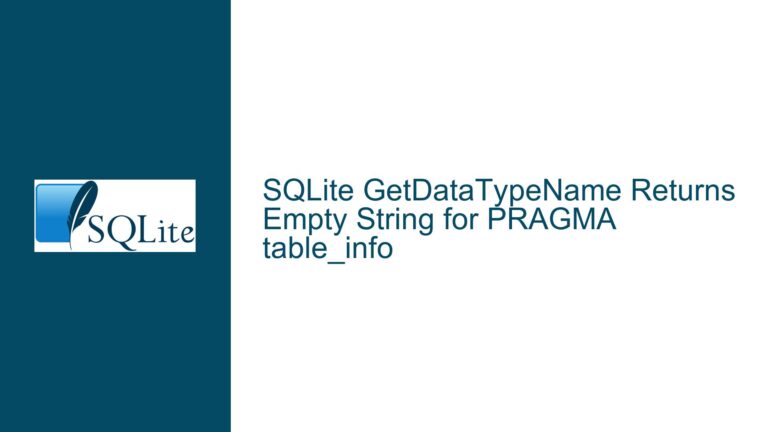Unused or Vestigial SQLite Linkage #Defines in Amalgamation
Issue Overview: Unused or Vestigial Linkage #Defines in SQLite Amalgamation
The SQLite amalgamation file (sqlite3.c) includes a set of preprocessor definitions (#defines) intended to provide flexibility in overriding linkage features of the SQLite interface. These definitions include SQLITE_EXTERN, SQLITE_API, SQLITE_CDECL, SQLITE_APICALL, SQLITE_STDCALL, SQLITE_CALLBACK, and SQLITE_SYSAPI. While SQLITE_API is extensively used, the others are either rarely used or entirely unused within the amalgamation. This raises questions about their necessity, purpose, and whether they should be retained, removed, or documented more clearly.
The core issue revolves around the following observations:
- Unused or Rarely Used Defines: Many of these
#defines, such asSQLITE_APICALL,SQLITE_STDCALL,SQLITE_CALLBACK, andSQLITE_SYSAPI, are never used within the amalgamation. Others, likeSQLITE_CDECLandSQLITE_EXTERN, are used only a handful of times. - Ambiguity in Purpose: The comment at the top of the section suggests that these defines are meant to "override linkage features of the interface." However, their lack of use within the amalgamation file itself makes their purpose unclear, especially for developers who rely on the amalgamation as their primary source of SQLite.
- Potential for Misinterpretation: Developers compiling SQLite for specific platforms (e.g., Windows) may set these defines based on the comment, even though they may have no effect. This can lead to unnecessary complexity and confusion in build configurations.
- Vestigial Code: Some of these defines, such as
SQLITE_STDCALL, appear to be vestigial remnants of older code or build processes. Their continued presence in the amalgamation without clear documentation or use cases adds to the confusion.
This issue is particularly relevant for developers who:
- Compile SQLite for specific platforms or environments where linkage and calling conventions are critical.
- Use the amalgamation file directly in their projects and need clarity on which defines are necessary.
- Maintain custom builds of SQLite and want to minimize unnecessary complexity in their build configurations.
Possible Causes: Why These #Defines Exist and Why They Are Unused
The existence of these #defines can be attributed to several factors, including historical design decisions, platform-specific requirements, and the need for flexibility in SQLite’s build process. However, their lack of use in the amalgamation file suggests that they may no longer serve their original purpose or are only relevant in specific build scenarios.
Historical Design Decisions:
- Some of these defines, such as
SQLITE_STDCALL, were introduced to support specific calling conventions or platform requirements that may no longer be relevant. For example,SQLITE_STDCALLwas historically used to support thestdcallcalling convention on Windows, but its use has been largely replaced bySQLITE_APICALL. - The presence of these defines may reflect a time when SQLite’s build process was more complex or when certain platforms required explicit control over linkage and calling conventions.
- Some of these defines, such as
Platform-Specific Requirements:
- SQLite is designed to be highly portable, and these defines may have been introduced to support specific platforms or environments where default linkage and calling conventions are insufficient. For example, Windows platforms often require explicit control over symbol visibility and calling conventions, which these defines can provide.
- However, the amalgamation file is typically used as a self-contained source file, and these defines may not be necessary unless the amalgamation is included in another compilation unit or built with specific options.
Flexibility in Build Process:
- The
mksqlite3c.tclscript, which generates the amalgamation file, includes an--apicalloption that enables the use of these defines. When this option is not used, the amalgamation file is generated with minimal annotations, and many of these defines are unused. - This suggests that these defines are primarily intended for advanced use cases or specific build configurations, rather than for general use in the amalgamation file.
- The
Vestigial Code:
- Some of these defines may be vestigial remnants of older code or build processes that are no longer relevant. For example,
SQLITE_STDCALLappears to have been replaced bySQLITE_APICALLin most cases, but it remains in the amalgamation file. - The continued presence of these defines may be due to a lack of cleanup or documentation, rather than an active need for their functionality.
- Some of these defines may be vestigial remnants of older code or build processes that are no longer relevant. For example,
Troubleshooting Steps, Solutions & Fixes: Addressing Unused or Vestigial #Defines
To address the issue of unused or vestigial #defines in the SQLite amalgamation file, the following steps and solutions can be considered:
Documentation and Clarification:
- The comment at the top of the section should be updated to clarify the purpose and usage of these defines. For example, it could specify which defines are used in the amalgamation file and which are reserved for specific build configurations or platforms.
- Documentation should be added to the SQLite website or build instructions to explain how and when these defines should be used, particularly for advanced use cases or specific platforms.
Selective Inclusion in Amalgamation:
- The
mksqlite3c.tclscript could be modified to omit unused defines from the amalgamation file when the--apicalloption is not used. This would reduce clutter and confusion for developers who do not need these defines. - Alternatively, unused defines could be marked as "reserved" in the amalgamation file, with a comment explaining their purpose and potential use cases.
- The
Cleanup of Vestigial Code:
- Defines that are no longer used, such as
SQLITE_STDCALL, should be removed from the amalgamation file and themksqlite3c.tclscript. This would simplify the code and reduce the potential for confusion. - If these defines are still needed for specific build configurations or platforms, they should be documented and their usage should be clearly explained.
- Defines that are no longer used, such as
Platform-Specific Build Instructions:
- For platforms that require explicit control over linkage and calling conventions, such as Windows, build instructions should be provided to explain how to use these defines. This could include examples of how to set these defines when compiling SQLite for specific platforms.
- The
--apicalloption inmksqlite3c.tclshould be documented, along with examples of how it affects the generated amalgamation file.
Contributor Guidelines:
- Contributors to SQLite should be encouraged to clean up unused or vestigial code and to document any new defines or build options they introduce. This would help maintain the clarity and simplicity of the SQLite codebase.
- A process for reviewing and approving changes to the amalgamation file and build scripts should be established to ensure that unnecessary complexity is avoided.
By addressing these issues, SQLite can maintain its reputation for simplicity and portability while providing the flexibility needed for advanced use cases and specific platforms. Developers who rely on the amalgamation file will benefit from clearer documentation and a more streamlined build process, reducing the potential for confusion and unnecessary complexity.






